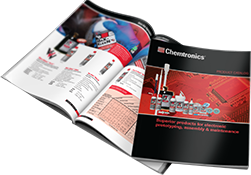
How do I remove temporary solder mask?
Peelable mask is usually removed by hand or with tweezers. Resourceful engineers have come up with devices with rotating brushes and other creative methods, but there is no commercially available equipment to speed this process along. Washable...
Read This Post
How can I prevent solder from breaking off in the through-holes?
Believe it or not, the way you hold the bottle can make a big difference on how easily the cured mask is removed. Many operators hold the bottle at a 90° angle as they drag the dispensing tip across the area they are masking. This has a...
Read This Post
How do I use temporary solder mask to protect contacts from conformal coating?
If you think of spot mask as basically liquid masking tape, the application become more intuitive: 1) Apply the mask to the contact areas to protect. Allow mask to fully cure. 2) Apply the conformal coating. 3) After the coating is dry to the...
Read This Post
How to I apply temporary solder mask?
Spot mask can be hand applied, dispensed with a pneumatic system, or stencil printed. To hand apply using a squeeze dispensing bottle: 1) hold the mask bottle upright, but at an angle (around 60°), 2) squeeze the bottle as you drag is across...
Read This Post
Is there a good way to remove labels and sticky residues?
Old identification or QC fault labels can be difficult to remove. They either leave sticky adhesive behind that is insoluble by commonly available solvents like isopropyl alcohol (IPA), or are so dried and baked-on that they won’t budge....
Read This Post
How do you repair black carbon conductor button pads on PCBs?
Chemtronics offers the CircuitWorks® Rubber Keypad Repair Kit, which can be used to repair keypads by restoring conductivity to worn, intermittent, and nonconductive carbon contacts. It is a 2-part mix, and comes with a swab, brush, and plastic...
Read This Post
What flux should I use when replacing PCB components?
CircuitWorks® flux pens are available with a variety of fluxes to fit your specific shop requirements, including: no-clean, high temperature no-clean for lead-free soldering, rosin, and water soluble. Flux pens are an excellent way to dispense...
Read This Post
How do you repair a PCB crack or open area of the solder resist on a PCB?
This answer assumes the crack does not impact surface or inner-layer traces. CircuitWorks Overcoat Epoxy provides a rugged repairs that can actually reinforce PCB areas with more structural cracks.
Read This Post
How do you repair a damaged pad on a PCB?
Standard 2-part epoxy can contaminate the surface of the connector, creating an insolative barrier. 2-part conductive epoxy is a great solution for making repairing damaged pads. This type of epoxy contains conductive material, so when cured,...
Read This Post
How do you repair breaks in EMI or RF shielding?
CircuitWorks Conductive Paint is a single component, silver-filled polymer that dries in minutes at room temperature, making it an ideal solution for patching EMI/RFI shielding. The kit comes with brushes, swabs, and a plastic pick to repair...
Read This Post


